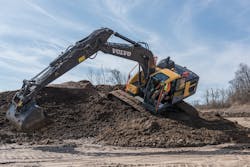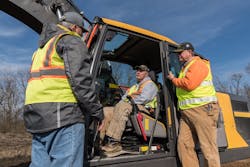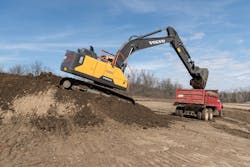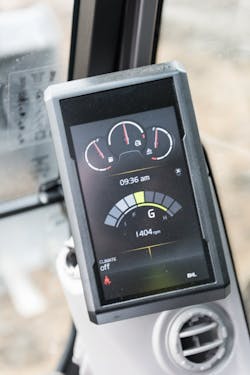Pros Assess Volvo EC220E’s Technology, Capabilities
The 22-ton-class Volvo EC220E is among the most technically advanced hydraulic excavators that Construction Equipment has encountered in its Field Test program.
For example, a nine-position rotary throttle functions as a work-mode selector, adjusting not only engine speed, but also, with each click, programming hydraulic-system parameters for application-specific performance. Also at the operator’s fingertips is a switch for an ECO-mode, which monitors engine-power output and hydraulic pressure in each of the work modes, adjusting the pumps to reduce power consumption and to prevent excess oil from being pushed over relief—an inefficiency that wastes fuel and hydraulic effort.
Above: Volvo’s John Duff, left, points out the EC220E’s features for Local 649 operator/instructors Terry Slater, right, and Jeff Braun. The operators chose to run the machine in its “backhoe” control pattern, selected via the EC220E’s pattern-changer lever in the filter compartment. All photos © Mike Boatman
In addition to these operator-selected features, the machine automatically determines if shifting hydraulic priority to arm or swing functions would be advantageous in a given situation, then adjusts the pumps and control valve accordingly by analyzing the operator’s use of the joysticks.
So, how do “old-school” veteran operators—who think that full-throttle operation is the only way to get any work done—react to the Volvo’s intelligence? And, in their opinion, does the machine have the brawn and balance to complement its advanced technology? Construction Equipment asked Operating Engineers Terry Slater and Jeff Braun to comment about these issues after they spent a good part of an unseasonably warm February day with the EC220E at IUOE Local 649’s 125-acre training facility in Bartonville (near Peoria), Ill.
Slater and Braun, instructors for Local 649’s apprenticeship program, didn’t hesitate to test the Volvo’s limits, working the machine at steep angles in spongy underfoot conditions; lifting trench boxes at maximum reach; and pushing the machine’s capabilities when trenching, grading, and loading trucks.
The EC220E used in the evaluation arrived from Volvo dealer Alta Equipment and was fitted with its standard one-piece boom; the longest (11 feet 6 inches) of five conventional digging arms; a Volvo UQF quick coupler (a universal type); and a 1.43-cubic-yard, 47.5-inch-wide general-purpose bucket. Additional fronts for the EC220E include a long-reach boom (29 feet), long-reach arm (20 feet 6 inches), two-piece boom, and buckets ranging from 0.63 to 1.66 cubic yards.
Design overview of the EC220E
The EC220E uses the 5.7-liter, Tier 4-F, Volvo D6 engine rated at 172 net horsepower. Volvo engines are noted for their relatively low-speed operation and good fuel economy, says the company’s John Duff—general purpose/production equipment product manager—who attended the Local 649 evaluation.
Volvo EC220E Specifications
- Operating weight: 43,350 - 55,360 lb.
- Engine: Volvo D6
- Power: 172 hp
- Hydraulic flow, max: 110 gpm
- Relief pressure, std: 4,980 psi
- Relief pressure, boost: 5,260 psi
- Max dig depth: 24 ft. 1 in.
- Max dig reach: 34 ft. 1 in.
- Max dump height: 22 ft.
- Tail-swing radius: 9 ft. 4 in.
- Width over tracks: 9 ft. 10 in.
“When the buyer activates the no-charge subscription to the machine’s CareTrack telematics system,” said Duff, “Volvo initiates its Fuel Efficiency Guarantee, which states that if the machine does not meet model-rated fuel-efficiency levels, the company will reimburse a portion of the additional fuel cost.”
The machine’s pilot-operated hydraulic system uses two variable-displacement pumps with a combined flow of 110 gpm. Main relief pressure is set at 4,980 psi, which is boosted to 5,260 psi for nine seconds with the Power Boost button, or remains at the higher setting when “F-mode” is selected via the rotary throttle.
The machine can remember pressures and flows for up to 20 attachments, and a number of auxiliary-hydraulic packages are available—all of which can be dealer installed. All auxiliary-line mounting blocks on the boom and arm are attached at the factory to avoid compromising these structures by in-field welding. (Volvo warrants the structural integrity of the boom, arm, and frames for the life of the machine for the initial owner.)
Commenting on the EC220E’s cab, both Slater and Braun agreed that the Volvo had ample room, an accommodating seat (heated), good visibility, easily accessible controls, and a good camera system—with images from two cameras, rear and optional right-side, controlled via a touch-pad switch for toggling through a split-screen view or a full-screen view from either camera. A short-cut button on the left joystick allows quickly accessing a selected camera view, or, the button can be programmed to operate the wipers or mute the radio.
Assessing features, performance
Very often, small details of a machine’s design catch the initial attention of seasoned operators.
For Braun, an initial impression was the EC220E’s quiet operation.
“When I first was working with the machine in the arena [Local 649 recently built an inside operating arena], you could hardly hear the machine running. When you’re in the cab with the door closed, you could be in your car or truck—it’s that quiet.”
Braun, who owned his own excavating business for 20 years and had a variety of excavator brands in his fleet, an early Volvo among them, was favorably impressed with the EC220E’s trenching ability.
“Trenching speed is really good—and it’s very smooth. You saw what I did—opened about 30 feet of 6-foot trench and sloped it along the way in just a matter of minutes. It did everything I asked—plus.
“I also liked the machine’s setup; with the long stick and big bucket, it’s a good sewer machine. Most people probably wouldn’t buy the long stick, opting instead for a shorter stick that they’d consider better for an all-around machine. But with the number of sticks Volvo offers, the buyer has lots of choice.
“Another plus, in my opinion, is the way the machine handles multiple hydraulic functions simultaneously. For instance, I was using travel, swing, and stick at the same time, and the machine performed without any hesitation.”
As mentioned, the EC220E has three joystick modes, which basically determine how much lever movement is required to activate a function. Braun recognized the value of the technology, but thought it might be more useful for less-experience operators.
“I used the joysticks in all three modes, and I didn’t see a lot of difference between active and normal, but soft slowed things down—not a lot, but probably enough to keep a novice operator from making a mistake around a utility.”
But when an operator isn’t a novice and has years of experience, like Braun, techniques learned over a couple decades or more are difficult to give up.
“My initial thought with any excavator is to put everything in high and do ‘Tasmanian Devil’ digging. That’s how I started with the Volvo—with the throttle in the H mode [the most aggressive work-mode setting on the rotary throttle]. But as John [Duff] pointed out, you no longer have to use the old-school, run-it-wide-open method to accomplish a lot of work.
“When I experimented with the G-mode [“general” work mode] settings, I found that I could actually speed up digging, because the machine itself was doing a better job of grading. I’m assuming, too, that I was saving fuel when I activated the ECO mode—and actually, didn’t see much of a difference in the machine’s performance in ECO—maybe just a bit slower.
“We old dogs need to remember that using a machine’s technology actually works in our favor—versus just hogging material. In our work with apprentices, Terry and I and our other instructors have to remember that the world is changing; we have to work at accommodating the technology and passing its value along to our students.”
Slater agreed. “When I turned the throttle back from H mode to a G mode when grading, the machine became smoother to operate—but actually maintained about the same working speed as at the higher throttle setting.”
For the novice operator, said Braun, the Volvo’s boom-float function would be of value, but maybe less so for the experienced operator.
“I think boom float would be useful for packing the trench or for speeding the digging cycle when trenching really deep, but trying to use it in a relatively shallow trench slowed me down. I also graded the trench with and without boom float and really didn’t notice much difference. But that said, an inexperienced operator could use that function—that technology—to do what I did manually and look like a genius.”
Keeping the foregoing observations in mind, Construction Equipment was interested in the operators’ opinions about a broader question: Do today’s machines have too much technology?
“Personally, my initial reaction is that they do,” said Slater. “All the electronic choices on new machines can be a bit daunting even for experienced operators, and even more so for the beginning apprentice. I don’t like a lot of extra buttons—don’t like spending several minutes trying to figure out how to start a machine that’s loaded with ‘technology,’ for instance. A lot of operators just start pushing buttons trying to figure out what does what.
“That said, I did find it relatively easy to maneuver through the Volvo’s various settings. It would be helpful, though, to have a quick-reference guide in the cab that concisely explains controls—so you could more intelligently choose settings that would be of benefit in a particular situation.”
Presenting technology in a manner that operators can understand and use, said Duff, is a challenge for equipment manufacturers.
“We recognize that machine technology can be intimidating for operators of all skill levels,” said Duff, “but we think Volvo’s design approach helps simplify using these advanced features—for instance, placing the throttle and work modes on one switch. The only function the operator really has to go into the computer for are the joystick settings—and 98 percent of operators will probably choose ‘normal’ and run with it. ECO mode is either on or off, and swing and arm priority are automatic functions picked up off joystick feedback.”
“I thought the machine responded well when lifting,” he said. “The different settings do allow you to idle down, but it still had the power at the lower settings— just a little slower.
“It’s a very smooth, stable machine,” said Slater, “but with that long stick, maybe it could use 1,000 pounds more counterweight. If you get a good bucketful of material out over the side, it tended to teeter just a bit, but as long as you were operating smoothly, it wasn’t a problem. I did have the machine at a fairly steep angle, though; if it had been sitting flat, that would have made a difference. Operators always want just a little more counterweight, because the hydraulic power is there and you want to use it. But I realize that machine weights are calculated to some extent on permitting requirements.”
Above: The monitor indicates the EC220E’s nine work modes, which are selected via rotary throttle in the right console.
Duff explained that typically with the long stick and a coupler, a smaller bucket would be used, because the coupler adds the equivalent of about an extra half yard of material.
“Depends on how you use the machine,” said Duff. “Some buyers want the big bucket for capacity, but if you’re typically going to be arming all the way out with heavy material, then maybe a smaller bucket is a better choice.”
While the machine was at a fairly steep angle on the spoil pile, Slater tested its swing power.
“It swung decently with a full bucket when I had the machine on the steeper slope,” he said, “but it didn’t make a full rotation without pulling in the stick some—but it did better than I thought it might. It has adequate swing torque, which is important when you’re doing slope work.”
Performance aside, Braun also took note of another EC220E design feature.
“Being able to stand on the ground and change all the filters in one place is a huge time saver,” he said. “Not having to climb up and down and back and forth to reach routine maintenance points is a feature owner/operators appreciate.”



